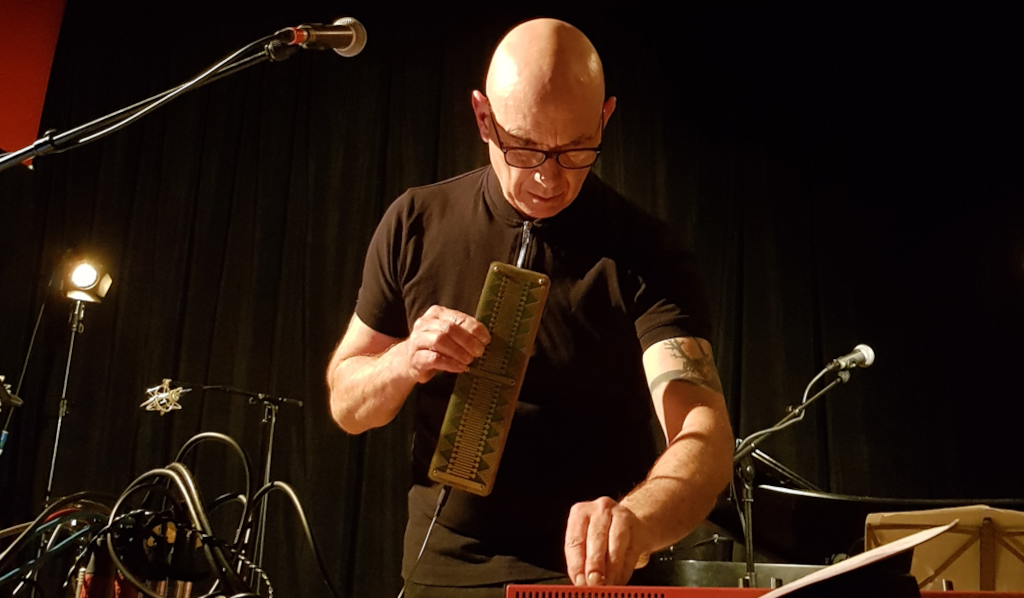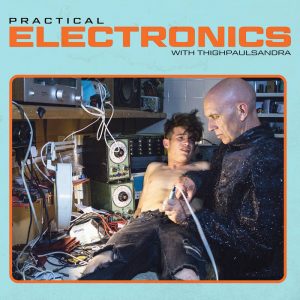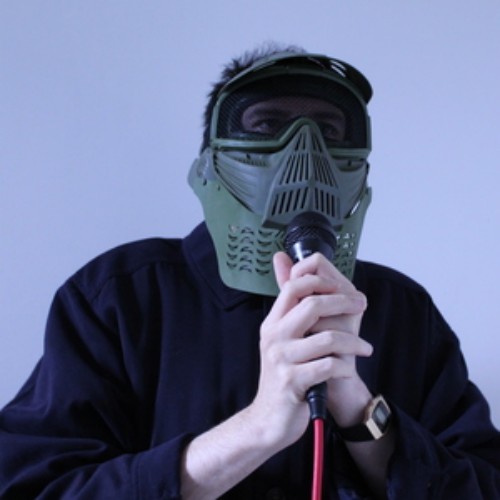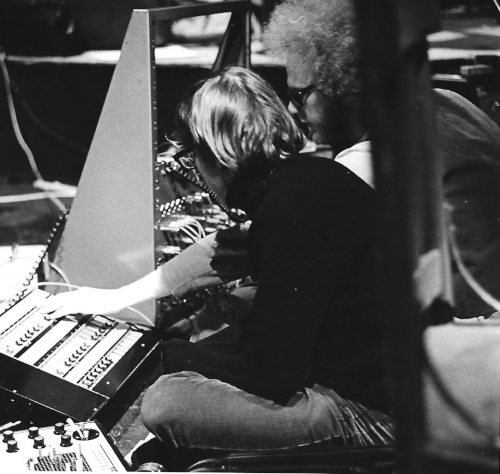 One of the most flamboyant, original and exciting of synthesists in the world of modular synths and beyond, Thighpaulsandra has been pushing the boundaries of electronic music as a solo performer and as a member of Coil, Uruk (as a duo with Massimo Pupillo) and UUUU (with Valentina Magaletti, Matthew Simms and Edvard Graham Lewis) or while working with Julian Cope, Spiritualized and more in ways both weird and wonderful for the better part of the century and before. His Modulisme session expands on the processes and compositions found on his most recent album, Practical Electronics With Thighpaulsandra, released by Editions Mego in 2019.
One of the most flamboyant, original and exciting of synthesists in the world of modular synths and beyond, Thighpaulsandra has been pushing the boundaries of electronic music as a solo performer and as a member of Coil, Uruk (as a duo with Massimo Pupillo) and UUUU (with Valentina Magaletti, Matthew Simms and Edvard Graham Lewis) or while working with Julian Cope, Spiritualized and more in ways both weird and wonderful for the better part of the century and before. His Modulisme session expands on the processes and compositions found on his most recent album, Practical Electronics With Thighpaulsandra, released by Editions Mego in 2019.
When did you first become aware of modular synthesis as a particular way of making music, whether as part of electronic music in general or more specifically as its own particular format, and what did you think of it at the time?
I probably became aware of synthesisers in general sometime in the early 1970s. I remember hearing Switched On Bach and being totally blown away. I didn’t know it was a modular synthesiser at the time. My parents hated any kind of popular music, but I could just about manage to to play SOB in the house without being shouted at.When I was at boarding school I remember hearing “Tank” by Emerson Lake and Palmer, realising this was a synthesiser and again being totally hooked on the sound. The physics department at my school had an EMS Synthi A on loan from Cardiff University and after being able to play with it I knew I had to have one. I sent off for a catalogue from EMS but they were £345, which was a huge amount of money in 1973. I still didn’t realise that this was a modular synth. I assumed all synthesisers were like that.
What was your first module or system?
The first synth I ever bought was a Roland SH5 (which I still have). I bought it in 1978 for £721 from the London Synthesiser Centre. The first semi-modular synthesiser I owned was an ARP 2600 which belonged to my next-door neighbour, Steve Howell. He’d just bought a Yamaha DX9 and sold me the ARP for £400. A few years later I bought an EMS VCS3, but my first proper modular synth was a Serge, which I bought from Rex Probe at STS.How long did it take for you to become accustomed to patching your own synthesizer together out of its component parts?
Oh pretty quickly. Even when I just had the SH5, I had it modified by one of the techs at Rod Argent’s keyboard store in London. The SH5 has pretty comprehensive modulation routings as standard for a mono synth, but I had it modified so that the oscillators and filters could accept more modulation sources. I’d also bought an Oberheim Mini-Sequencer and an RSF Kobol Expander that I could use with it.
The Oberheim enabled me not only sequence the SH5, but also gave me another sample and hold. The RSF, whilst already being a self-contained synthesiser, enabled me to use its oscillators to do things like FM the SH5 filter and it had patch points for most of the functions. I soon found I could use the Oberheim sequencer to do things like change the attack time or oscillator waveform. The possibilities opened up pretty quickly, and because it was quite a small and limited system I got to know it really well.Do you prefer single-maker systems (for example, Buchla, Make Noise, Erica Synths, Roland, etc) or making your own modular synthesizer out of individual components form whatever manufacturer that match your needs.
Generally not. I’m sure if I had a large Buchla 200 or 200e I might be quite happy to stay within that system, but I’ve always viewed my modular system as just a group of tools to be used in various combinations. My current modular system comprises of two ARP 2600s, two Synton Fenix, a Synton 3000 panel, three panels of Serge, two Oberheim SEMs and the Mini-Sequencer (with all the patch points brought out to a panel), the RSF Kobol Expander, a Behringer Neutron and 18U of Eurorack modules. Even though I have banana jacks, 1/4 and 3.5mm jacks in the system and slightly different operating voltages between each, I use it all together with custom cables that enable me to convert any format.I have way more Eurorack modules than I have cases to put them in, so I’m trying to build a new case that will also act as a base for the two 2600s and also get me off the floor. Currently I have to sit or lie on the floor do some of the patching.
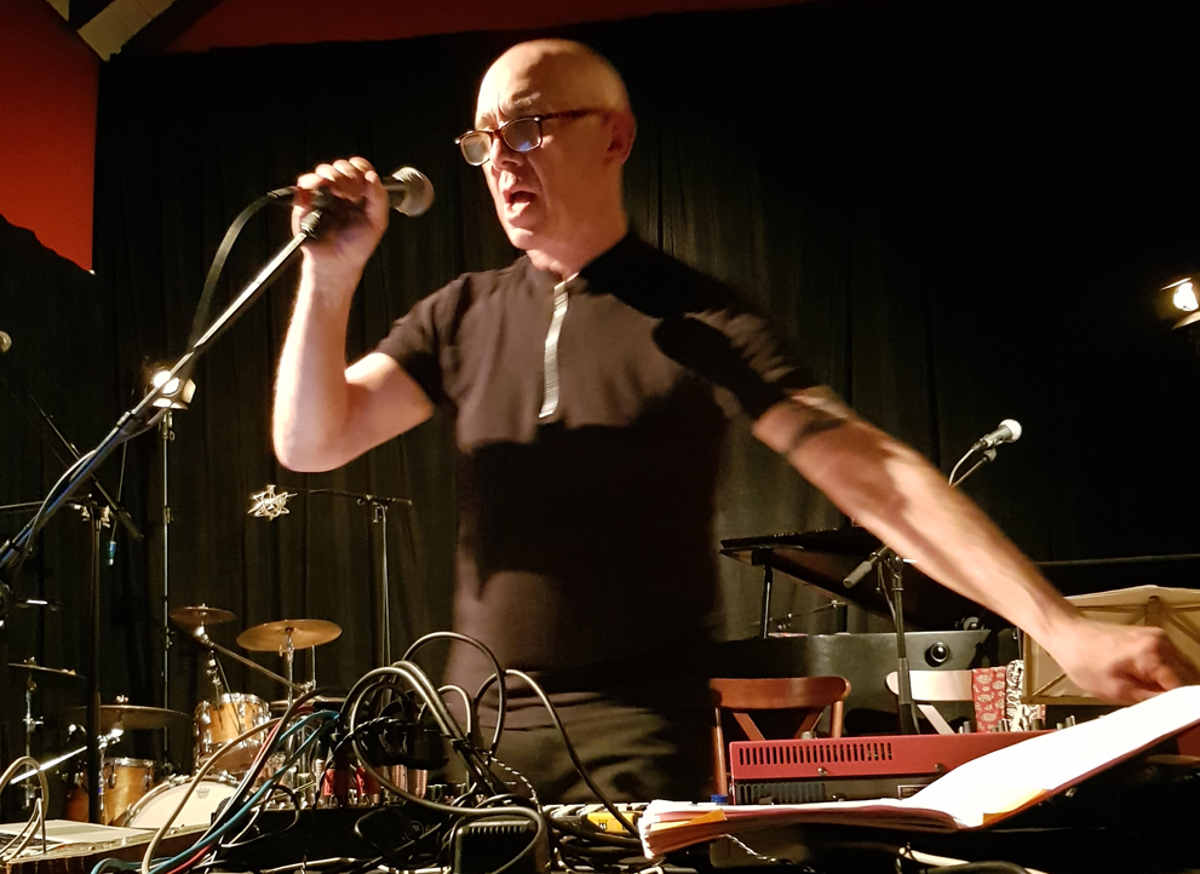
East Coast, West Coast or No-Coast (as Make Noise put it)? Or is it all irrelevant to how you approach synthesis?
It really is irrelevant to me. I don’t generally try to emulate any school of synthesis. My aim is to create sounds that hopefully give my music some stamp of originality. I suppose having the Serge and then being introduced to some more “West Coast” concepts like low-pass gates when I bought some from Peter Grenader back in 2005 changed the way I achieved some sounds.I always loved the sounds Karlheinz Stockhausen produced with band-pass filters and tape manipulation, and the way Morton Subotnick used pitch and envelope followers to control synthesizers without knowing how those things were achieved. It was the organic nature of their sounds that interested me more than the actual techniques themselves.
Do you tend to use pure modular systems, or do you bring in outside effect and devices when playing or recording?
Yes, I’m no purist. I’ll use anything that comes to hand. I’m a great believer in horses for courses. I’ve got various instruments that I use for specific tasks and I tend to fall in love with them because they excel in those areas. If I want to make thin reed sounds I’ll usually turn to my Yamaha VL1. I’ll use my Kurzweil K2000 for making distorted industrial loops or my Prophet 5 for wobbly pads. I quite often use various bits of old outboard gear to process sounds too.I have an old Roland SBF 325 flanger that allows you to use an external modulation source to control the sweep, which means I can modulate it at audio rates. I also have a modified Electro-Harmonix sixteen-second delay that I use for processing. Sometimes I’ll run the output of a wavetable synth like the PPG or Waldorf Microwave into a Marshall stack and then make a sample from that, which I’ll either modify further in the K2000, MOTU Mach 5 or maybe the Tasty Chips GR-1. I spend a lot of time exploring sound.
Do you find that you record straight with no overdubbing, or do you end up multi-tracking and editing tracks in post-production?
Minimalism isn’t my strong point. Less is rarely more in my world. Generally I have a musical idea in my head and then do whatever it takes to achieve it. That may involve dense multi-tracking, midi sequencing, acoustic and electronic instruments, vocals or whatever the piece needs. Quite often when working on the modular I will write midi events in Pro Tools and then use those to control the modular via a Kenton Pro 4 midi-cv converter. The computer takes care of the triggering, leaving two hands free to manipulate the sound.At other times I dedicate days to experimentation, just create a patch on the modular and see where it takes me. I tend to record everything, bank it, then review it later. I’ll review things in a few month’s time and if I like them I’ll keep them, occasionally inspired enough to work on them immediately, but otherwise I’ll edit them and make notes for future use. Quite a lot of stuff ends up in the bin.
Do you pre-patch your system when playing live, or do you tend to improvise on the spot?
In my current live set I’m trying to reproduce the songs on my last album, so I tend to use my Nord Modular G1 for most of the sounds. I’ve done my best to replicate some of the sounds on the album, so those are written in stone and are just recalled from memory. I have other patches in the Nord that are a lot more experimental and unpredictable, so I use those in the more improvised parts of the set. I’m also running u-he Zebra and Madronna Labs Kaivo and Aalto on a Macbook Pro.I’d love to use more hardware modular on stage, but I’m yet to build a system that I’m both comfortable with to use live and that is small enough to fly with. In my Coil days we had three Synton Fenixs on stage and they became really battered from touring. It’s just not feasible to fly with that amount of gear now and without some sort of patch recall I’d have to take mountains of gear to make all the sounds.
Also, I have to say I’m not a great fan of many of the artists who just improvise with modular. Everyone seems to go in a similar direction, and I don’t find that very musical or exciting. There’s only so much drama one can imbue in plugging in a patch cord or twiddling a knob, so some people’s modular performances make me laugh. Most people seem to go down the tedious dance music route or produce insipid ambient noodlings. I’m not really interested in doing those kinds of things and generally my favourite use of synthesisers is in the context of other instruments.I had some plans to do shows with just piano and a small modular system. I think that could be quite interesting, but that’s on hold till the current situation eases.
 Which module could you not do without, or which module do you you use the most in every patch?
Which module could you not do without, or which module do you you use the most in every patch?
What do you think that can only be achieved by modular synthesis that other forms of electronic music cannot or makes harder to do?
For me modular synthesizers are just another tool. I love them and they certainly allow me to explore the extremities of my imagination, but I’m sure if they were all to disappear tomorrow I’d still find ways of making the sounds I want. Sometimes I deliberately avoid using the modular and try to achieve the sound in my head by other means. This could involve external processing with effects or tape, or even making samples of other instruments and modifying them.
Have you used various forms of software modular (eg Reaktor Blocks, Softube Modular, VCVRack) or digital hardware with modular software editors (eg Nord Modular, Axoloti, Organelle), and if so what do you think of them?
I tried Reaktor and didn’t really get on with it. I also have the Softube Modular, but I find the interface incredibly frustrating. I really love the Nord Modular G1 and rely on it very heavily for my live set, but I’ve also used it on quite a few recordings. The software, which I run on an old Macbook, is really clunky, but I know my way around it really well and I’ve made sounds on it that I haven’t been able to achieve on anything else. I’ve used a Nord G2 on several occasions and I’d love to pick up one of those at some point too.My other favourite soft synth is the u-he Zebra, which I think is incredibly under-rated. Again, for me it’s very quick, I can patch something together in a matter of seconds, it seems very stable and I often end up using it on records just because it sounds so good. Last year I bought a Haken Continuum. The synth engine, the Eagan Matrix, is essentially an incredibly complex modular synthesiser environment. As much as I love it, I find the programming interface hard to get my head around as it requires a basic mathematical knowledge that I am sadly lacking; but I intend to persevere with it as it’s able to produce sounds that are on an entirely new level of complexity and realism.
What module or system you wish you had?
I’d love an old Buchla 200. I’ve only had the pleasure of using one a few times, but I just love the character and the workflow.
Have you ever built a DIY module, or would you consider doing so?
I’ve bought quite a few but never built them myself. My eyesight is atrocious, so I can’t solder very well anymore. Also I have limited patience with things like that. I’m sure if it didn’t work first time it would end up in the bin.Which modular artist has influenced you the most in your own music?
In strictly modular terms probably Wendy Carlos and Morton Subotnik. I’m generally more interested in what might be termed more electro-acoustic composers like Tod Dockstader, Bernard Parmegiani and Jerome Noetinger.
Can you hear the sound of individual modules when listening to music since you’ve been part of the modular world — how has it affected (or not) the way that you listen to music?
Haha, yes I’m beginning to. Not that I listen to many modular performers but, on the rare occasions I do, I can definitely spot that “Make Noise sound”’ and the sounds of Mutable Instruments Clouds, Braids and Plaits. I had to take Clouds out of my system as I realised I was just making the same sounds as everyone else. I guess we’ll all look back in thirty years time with the same sense of nostalgia we now have for the sound of a guitar through a Roland JC120 chorus or a Fairlight sample.What have you been working on lately, and do you have any upcoming releases or performances?
I was supposed to be on tour playing keys for Tim Burgess this year, but due to the pandemic I’ve been largely confined to various studios. I’ve actually really enjoyed the time as I’ve been able to devote a considerable amount of attention to my own music. At the moment it looks as though I have probably two albums near completion. One is quite song based and the other contains more improvised and instrumental pieces. However, all this could change and the two albums could merge. At this point it’s difficult to predict.
Can you outline how you patched and performed your Modulisme session?
I used my modular system for the bulk of the sounds. I used an ASM Hydrasynth for the polyphonic parts and the parts where I play a melody and an EMS Synth AKS in a couple of sections. I also played a French horn in one section, which is only picked up by the spring reverb in the AKS. The drum-like sounds are created with a Verbos Complex oscillator and the Xaoc Odessa through two channels of a Natural Gate and a Plan B Model 13.When improvising with the modular, I like to create a few patches that are in some way self-generating so that I can just fade them up and have something to play against. For this I use my ARP sequencer and my Plan B Model 21 sequencer, as I am able to voltage control the clocks for some random elements. I love the Plan B Model 24 for random voltages and triggers. For the percussive sequence in the last section, I used an Arturia Beatstep Pro. The melodic solo section was played on the Hydrasynth through a modified Electro-Harmonix sixteen-second delay.
“The Floating Ear”
I used similar wavetables on both instruments so they sound largely like one part, although my PPG has a fault which results in one voice being much louder and brighter than all the others. It’s a fault I’ve grown to love and am loathe to have repaired. The sequence that fades in the middle section was created on Mutable Instruments Rings FM’d by a Plan B Model 15 oscillator.
“Trouble With Breeders”
The modular is creating a random percussive patch and two random washy patches, which are two unsynced random sequences of the same thirteen notes tuned an octave apart feeding Fenix oscillators and controlled through VCAs by very slow randomly modulated LFOs, eventually being summed into a Make Noise Erbeverb. I had no control over the washy part, it being in the control room while I performed in the live room, but there were some very fortunate harmonic synchronisations and accidents. I had a small Eurorack modular case set up on the piano for the percussive parts along with a Haken Continuum for a couple of polyphonic interludes.
Who would your dream collaborator be for a Modulisme session or otherwise?
Probably someone who works in a totally different way than I do. I’d really love to work with Fred Frith, Jerome Noetinger or Robert Wyatt. I suppose my dream would be to have John Balance and Sleazy back as I really loved the music we made together.One can but dream.
*
Live photographs by Michael Rodham-Heaps.

